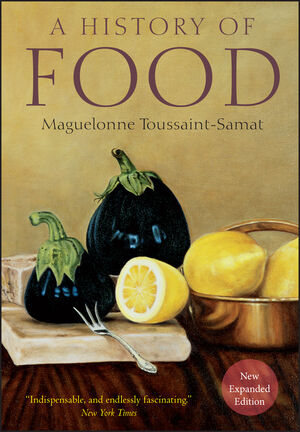A History of Food, 2nd, New and Expanded EditionISBN: 978-1-4051-8119-8
Hardcover
776 pages
November 2008, Wiley-Blackwell
 |
||||||
"A History of Food is a concise yet massively entertaining read that looks at the earliest hunter-gatherer societies and moves on to bring readers right up to the modern day. … It goes quite well with a cup of tea and a biscuit, and dipping in anywhere will uncover something delicious." (Heritage Key, December 2009)
"The reader will be amazed and fascinated by the dizzying array of details about various foods in this 700-page tome." (Choice Reviews, May 2009)
"Classic text … .[Brought] up to date by including 'the latest scientific and technological discoveries' regarding the food we eat." (Contemporary Review, 2009)
"This densely informed history ranges from the first bread loaves to the low-down on cauliflowers. Fab for food geeks, it's one to dip into rather than devour in one go." (Metro, December 2008)
"The second edition of this dense tome is perfect for the historian on your list." (San Francisco Chronicle, December 2008)
"This densely informed history ranges from the first bread loaves to the lowdown on cauliflowers. Fab for food geeks, it's one to dip into rather than devour in one go." (Metro Food Books of the Year, December 2008)
"A fascinating study that starts with the era when we are all still living in trees. Scrupulously thorough and pleasingly idiosyncratic, it promises the reader many a happy hour blissfully contemplating our ancient relationship with our stomachs. And that’s as much as you can ask from any food book." (Independent, November 2008)
"Forceful and challenging … A powerful, compelling and readable case against biblical literalism and fundamentalism." (Times Higher Education, November 2008)
"Encyclopaedic in scope, the result is never dull … You will find it, I guarantee, unfailingly witty and comprehensively rewarding." (The Glasgow Herald, November 2008)
"Scrupulously thorough and pleasingly idiosyncratic, it promises the reader many a happy hour blissfully contemplating our ancient relationship with our stomachs. And that's as much as you can ask from any food book." (The Independent, November 2008)
"A fascinating, enormously impressive work which will delight not just the foodie but anyone in social history." (Tribune, November 2008)
"Toussaint Samat presents not just the historical background but the cultural, religious and social impact of food. Extensively researched with quotations from a wide array of historical sources … .Some areas receive more intense scrutiny—wine for example … .A useful source for students or researchers as a strong first reference point and for anyone with a dedicated interest in food history. Recommended for larger public and academic libraries." (Library Journal, November 2008)
"First published in France in 1987, the second edition of this
dense tome is perfect for the historian on your list. It explores
the 10,000-year-old relationship between humans and food, including
facts about foie gras, the history of olive oil and the symbolism
of poultry." (San Francisco Chronicle, November 2008)
"A fascinating study that starts with the era when we were still
living in trees (yes, really). Scrupulously thorough and pleasingly
idiosyncratic, it promises the reader many a happy hour blissfully
contemplating our ancient relationship with our stomachs. And
that's as much as you can ask from any food book." (The
Independent on Sunday, November 2008)
"A fascinating, enormously impressive work which will delight not just the foodie but anyone interested in social history." (Tribune, November 2008)
"This excellent guide is an exploration of man's relationship with food from the discovery of fire onwards." (The Independent, October 2008)
"This book should be republished and re-titled THE History of Food. It's probably the most remarkable book on the subject I have ever had the pleasure of reading." (Mostly Food Journal, October 2008)
Praise for the First Edition:
"Indispensable, and an endlessly fascinating book. The view is staggering. Not a book to digest at one or several sittings. Savor it instead, one small slice at a time, accompanied by a very fine wine." (New York Times)
"This book is not only impressive for the knowledge it provides, it is unique in its integration of historical anecdotes and factual data. It is a marvellous reference to a great many topics." (Raymond Blanc, Restaurateur Writer)
"Quirky, encyclopaedic, and hugely entertaining. A delight." (Sunday Telegraph)
"It's the best book when you are looking for very clear but interesting stories. Everything is cross-referenced to an extraordinary degree, which is great because the information given is so complex and interweaving." (The Independent)
"A History of Food is a monumental work, a prodigious feat of careful scholarship, patient research and attention to detail. Full of astonishing but insufficiently known facts." (Times Higher Education Supplement)
"For those of us virtually weaned on this monumental landmark when it was first published, the expanded, updated edition of A HISTORY OF FOOD couldn't be a more welcomed and exciting surprise. While the hefty volume is an indispensable source of valuable facts and information for anyone interested in the worldwide development of numerous foods and the intriguing evolution of man's dietary habits over the centuries, the book also happens to be, quite simply, a wonderful and inspiring read--to be dipped into like a bowl of fresh wild strawberries."–James Villas, former food and wine editor of Town & Country magazine, and author of The Glory of Southern Cooking and Between Bites: Memoirs of a Hungry Hedonist
“This amazing and most entertaining book presents anything you might want to know about the cultural history of food forever and everywhere. It’s a great place to find the symbolic meaning of food myths, legends, and revels, not to mention the dietetics of cherries and other nutritious foods. It should be a welcome addition to the library of every food studies scholar.”
–Marion Nestle, Paulette Goddard Professor of Nutrition, Food Studies, and Public Health at New York University and author of What to Eat



